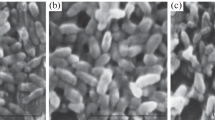Abstract
Picrophilus oshimae is an extremely acidophilic, thermophilic archaeon that grows optimally at 60°C and at pH 0.7. It is an obligatory acidophile that does not grow at pH values above 4.0. The proton motive force in respiring cells is composed of a large transmembrane pH gradient, inside less acid, and a reversed transmembrane electrical potential, inside positive. Cells maintain an intracellular pH at around 4.6 at extracellular pH values ranging from 0.8 to 4.0. Above pH 4.0 cells lyse rapidly and lose their viability. Liposomes prepared from lipids derived from P. oshimae have an extremely low proton permeability at acidic pH. However, at neutral pH, the lipids are unable to assemble into regular liposomal structures. These observations suggest that the loss of viability and cell integrity above pH 4.0 is due to an impairment of the barrier function of the cytoplasmic membrane.
Similar content being viewed by others
Author information
Authors and Affiliations
Additional information
Received: July 18, 1997 / Accepted: November 25, 1997
Rights and permissions
About this article
Cite this article
van de Vossenberg, J., Driessen, A., Zillig, W. et al. Bioenergetics and cytoplasmic membrane stability of the extremely acidophilic, thermophilic archaeon Picrophilus oshimae . Extremophiles 2, 67–74 (1998). https://doi.org/10.1007/s007920050044
Issue Date:
DOI: https://doi.org/10.1007/s007920050044




